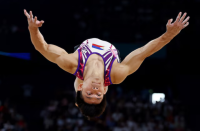https://youtu.be/NzWUaQcV4Gw
In swimming, mastering racing dives, dolphin kicks and turns can shave tenths of a second off the clock.
There are two starting techniques:
-The grab start, seen as the most powerful, where the swimmer grips the block with their hands and toes, their body weight over the front of their feet.
-And the track start, which allows a faster reaction time. The swimmer positions their hands and one foot on the block’s edge, body weight on the leg behind.
At the starting signal, the swimmer pulls down on their arms to swing their body forward and then, as in the ‘grab start, stretch their arms forward, straighten their head before tucking it in as their legs leave the block.
The swimmer controls their body to slice into the water in one movement, limiting resistance then bending to avoid too deep a dive.
After diving and turning, swimmers are allowed to remain underwater for no more than 15 meters. Holding their upper bodies in a streamlined position, they are only allowed to dolphin kick with their legs.
The body remains in a hydrodynamic position until they lose speed and start swimming. Beginning a stroke too soon or too late could waste valuable energy or break their rhythm.
To execute a good turn, it is necessary to use the pool’s markers as a guide to choose the right moment to somersault, without slowing down while approaching the wall.
Arms should be stretched and hands steady, to avoid wasting momentum and reducing the efficiency of pushing off the wall
(Courtesy AFP videographics)






